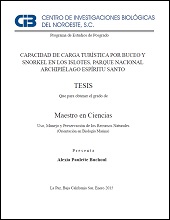Mostrar el registro sencillo del ítem
Capacidad de carga turística por buceo y snorkel en Los Islotes, Parque Nacional Archipiélago Espíritu Santo
| dc.contributor.advisor | Balart Páez, Eduardo Francisco | |
| dc.contributor.author | Buchoul, Alexia Paulette | |
| dc.date.issued | 2016 | es_MX |
| dc.identifier.uri | http://dspace.cibnor.mx:8080/handle/123456789/500 | |
| dc.description.abstract | “Los Islotes”, área insular arrecifal ubicada en el extremo norte del Parque Nacional Archipiélago Espíritu Santo, posee una gran biodiversidad e importancia socioeconómica en la región. Por eso, las autoridades están particularmente interesadas en su uso sustentable, protección y conservación a largo plazo. Para apoyarlas a tomar oportunamente las medidas necesarias para asegurar el uso sustentable del arrecife, se evaluó el impacto del buceo recreativo y snorkel mediante el indicador capacidad de Carga (CC) por buzos/buceos por día/mes/año. Su cálculo implicó la caracterización del área de estudio así como la capacidad de manejo del sitio por parte de la autoridad del Parque. Se determinó el nivel de uso del sitio por mes y por zona para buceo diurno y nocturno. El daño antropogénico fue medido mediante un seguimiento de los buzos por 10 minutos, en el cual el número de contactos sobre el arrecife y organismos fue registrado. El perfil y percepción de los visitantes fue obtenido mediante encuestas proporcionadas a los turistas. La CC por zona y para el sitio completo fue evaluada. En la actividad de buceo con snorkel, las manos fueron el medio de contacto más frecuente (77.6 %), contactando mayoritariamente a lobos marinos (69%) y estrellas de mar (13%); en el buceo Scuba lo fueron las aletas (44%) seguido de las manos (28 %), siendo el contacto con el sustrato rocoso lo más frecuente (70%) y con lobos marinos (11.5%). Durante el año de estudio (marzo 2014 – febrero 2015), la afluencia turística fue de 19,317 visitantes (3,920 buzos Scuba y 15,397 snorkels). La capacidad de carga anual calculada fue de 51,757 visitantes (23,287 buceos Scuba y 28,470 snorkels). Se concluye que la CC no está actualmente sobrepasada en “Los Islotes”, ya que el sitio explota solamente el 16.8 % de su capacidad total para la práctica del buceo y al 54.5 % para la actividad de snorkel. Sin embargo, el análisis por zona indica que si hay un foco rojo en una zona que atender. | es_MX |
| dc.language.iso | Español | es_MX |
| dc.publisher | Centro de Investigaciones Biológicas del Noroeste, S.C. | es_MX |
| dc.title | Capacidad de carga turística por buceo y snorkel en Los Islotes, Parque Nacional Archipiélago Espíritu Santo | es_MX |
| dc.type | Tesis | es_MX |
| dc.documento.id | buchoul_a | es_MX |
| dc.documento.inst | CIBNOR | es_MX |
| dc.dirtesis.grado | Maestría en Ciencias en el Uso, Manejo y Preservación de los Recursos Naturales | es_MX |
| dc.dirtesis.disciplina | Biología Marina | es_MX |
| dc.dirtesis.universidad | Centro de Investigaciones Biológicas del Noroeste, S.C. | es_MX |
| dc.dirtesis.facultad | Posgrado en Recursos Naturales | es_MX |
| dc.documento.fecha | 2016-02-26 | |
| dc.description.abstracten | “Los Islotes”, insular reef area located at the northern end of the Espíritu Santo island National Park. Has a rich biodiversity and socio-economic importance in the region Therefore, the authorities are particularly interested in their use, protection and long-term preservation. To enable the authorities of the Marine Protected Area opportunely take the necessary measures to ensure sustainable use of the reef, the impact of recreational diving is measured by the carrying capacity (CC) indicator by divers/dives per day/month/year was evaluated. Its involves the characterization of the study area in term biophysical and management capacity of the site. Dive surveys will be conducted to obtain the inventory of organisms present in the site. The level of use of the site was determined. Anthropogenic damage to the bodies was measured by tracking the divers for 10 minutes, the number of contacts on the reef and organisms involved will be recorded. The profile and perception of visitors was obtained through surveys provided to tourists. Subsequently, the CC was calculated by area and for the entire site. For snorkels, hands were the most frequent means of contact 77.6%, mostly contacting sea lions (69%) and stars (13%). As for diving were the fins (44%), followed by hands (28%), on rocky layer contact in the majority (70%) and sea lions (11.5%). During the year of study (March 2014 - February 2015), the number of tourists was 19,317 visitors (3,920 Scuba diving and 15,397 Snorkeling). The annual carrying capacity was calculated at 51.757 visitors (23.346 Scuba diving and 28.470 snorkeling). In conclusion, the CC is not currently exceeded in "Los Islotes", as the site exploits only 26% of total capacity for diving and 45.5% for snorkeling activity. However, the analysis by zones show there is a red light in one zone to attend. | es_MX |
| dc.documento.subject | Capacidad de Carga; Buceo recreativo; Parque Marino Archipiélago Espíritu Santo; Golfo de California | es_MX |
Ficheros en el ítem
Este ítem aparece en la(s) siguiente(s) colección(ones)
-
Tesis Digitales CIBNOR
Esta colección contiene texto completo de las tesis de Maestría y Doctorado del Programa de Posgrado del CIBNOR.

